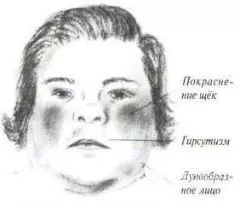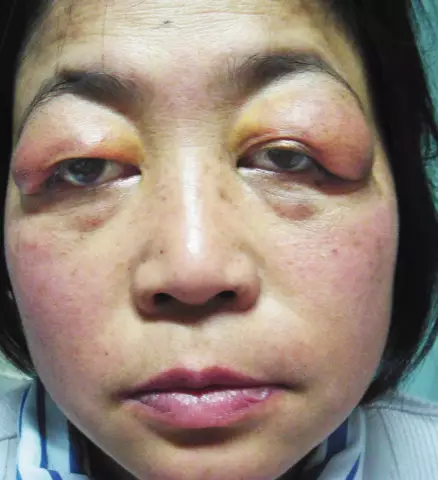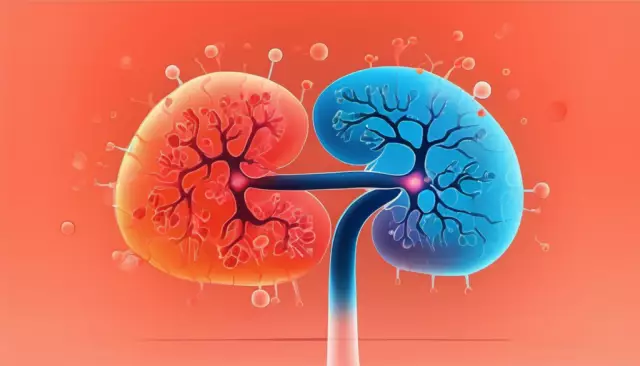- Author Rachel Wainwright [email protected].
- Public 2023-12-15 07:39.
- Last modified 2025-11-02 20:14.
Itsenko-Cushing's syndrome

In medicine, Itsenko-Cushing's syndrome is usually called a disease that entails a large number of symptoms resulting from an increase in the concentration of glucocorticoid hormones in the human body.
Causes of Itsenko-Cushing's syndrome
- Inflammatory processes occurring in the brain (in particular, due to a pituitary tumor).
- In some cases, it occurs in the postpartum period in women.
- Tumors of the adrenal glands.
- Tumors of the pancreas, bronchi and lungs, mediastinum, which inevitably leads to symptoms of Itsenko-Cushing's syndrome.
During the diagnosis of the analyzed disease, it is necessary to remember that Itsenko-Cushing's syndrome combines a large number of painful conditions (adrenal cancer, Cushing's disease, an increase in ACTH, etc.). In addition, a patient with Itsenko-Cushing's syndrome must undergo additional examination and refuse to take drugs that contain glucocorticoids (for example, taking prednisolone or similar drugs for a long time can cause the development of the disease under study).
After identifying the symptoms of Cushing's syndrome, it is impossible to tell right away which disease is typical for a particular patient: adrenal cancer or Cushing's disease. Quite often, in men with adrenal cancer, the female hormone begins to prevail in the body, while in women, on the contrary, male symptoms appear. It should also not be forgotten that in medicine there is a pseudo-Cushing's syndrome that occurs in patients who become depressed or who drink alcohol for a long time. As a result of such diseases, the normal functioning of the adrenal glands stops, and they begin to produce excess glucocorticoid hormones, which leads to the onset of symptoms of Itsenko-Cushing's syndrome.
Prevalence
Itsenko-Cushing's syndrome occurs in children, and can also develop at any age. However, most often it occurs in people whose age ranges from 20-40 years. It should be noted that in women this disease occurs 10 times more often than in men.
Symptoms of Itsenko-Cushing's syndrome
Among the most common symptoms of Itsenko-Cushing's syndrome are obesity of the trunk, neck and face. In patients with this disease, the face becomes round, the arms and legs become very thin and thin, the skin dries out excessively and in some places it becomes red-blue (on the face and in the chest area). Often, the tips of the fingers, lips, and nose turn blue (acrocyanosis develops). The skin becomes thinner, veins are clearly visible through it (most often this occurs on the limbs and chest), stretch marks are clearly visible (on the abdomen, thighs, legs and arms). In places of friction, the skin often takes on a darker shade. In women, excessive hair growth is observed on the face and limbs.
In addition, blood pressure is constantly increasing. Due to a lack of calcium in the body, changes in the skeleton are observed (in severe forms of the disease, fractures of the spine and ribs occur). Metabolic processes in the body are disrupted, which entails the development of diabetes mellitus, which almost never gives in to treatment. Patients with this condition may experience frequent depression or overexcitement.
The symptoms of Itsenko-Cushing's syndrome are also a decrease in the concentration of potassium in the blood, while hemoglobin, erythrocytes and cholesterol increase significantly.

Itsenko-Cushing's syndrome has three forms of development: mild, moderate and severe. The disease can develop in a year or half a year (very rapidly), and it can gain momentum within 3-10 years.
Diagnostics of the Itsenko-Cushing syndrome
- The amount of cortisol in the blood and urine is determined. A blood test is taken to establish the amount of ACTH in it (a night increase is the most truthful indicator in this analysis).
- With the help of special studies, the source of increased production of hormones (adrenal glands or pituitary gland) is established. A computed tomography of the skull is performed, as a result of which a pituitary adenoma is determined, as well as an increase in the adrenal glands. Thanks to tomography or scintigraphy, adrenal tumors are diagnosed.
- To exclude possible tumor development of the adrenal cortex, special tests are performed using dexamethasone, ACTH or methapyrone.
Treatment of Itsenko-Cushing's syndrome
- If the symptom of Itsenko-Cushing's syndrome is a pathological condition of the pituitary gland, then the only correct solution is the complete removal of the pituitary gland.
- In the event that the patient has an adrenal adenoma, the treatment for Itsenko-Cushing's syndrome is the removal of the adenoma, including laparoscopic removal of the adrenal gland - laparoscopic adrenalectomy. In a severe form of the disease, two adrenal glands are surgically removed, which entails permanent adrenal insufficiency. Only appropriate therapy can maintain the patient's normal condition.
- Laparoscopic adrenalectomy is used not only to treat Itsenko-Cushing's syndrome, but also to eliminate endocrine diseases that arise due to poor functioning of the pituitary gland or adrenal glands, which can lead to the development of symptoms of Itsenko-Cushing's syndrome. Nowadays, such an operation is widespread throughout the world. If it is not possible to perform surgical intervention on the pituitary gland, then bilateral laparoscopic adrenalectomy is performed.
- Treatment of Itsenko-Cushing's syndrome in children and adults with adrenal cancer is determined for each individual patient. The mild to moderate form of the disease is treated with radiation therapy. If this method of treatment does not have the proper results, one adrenal gland is removed or Chloditan is prescribed with other drugs.
- The goal of conservative therapy is to restore mineral, protein, carbohydrate metabolism. For the treatment of Itsenko-Cushing's syndrome, diuretics, cardiac glycosides, and blood pressure lowering drugs are often prescribed.
YouTube video related to the article:
The information is generalized and provided for informational purposes only. At the first sign of illness, see your doctor. Self-medication is hazardous to health!






